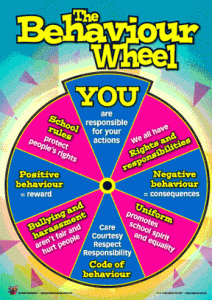The management of behaviour is often sadly misinterpreted as merely dealing with poor behaviour and the sanctions that should be associated with this. There is so much more to it than this though.
There are occasions where bad behaviour may persist, which requires an intervention from the teacher and the threat of a later sanction. However, an effective way of dealing with a problem is to allow the child to be responsible for and to regulate their own behaviour. It is up to them to make wise choices about whether they choose to follow instructions or face the consequences for opting against them. The benefits of this are that the child can take ownership of their behaviour, meaning they are in control of how they decide to act. Also, self regulation provides an opportunity for peer and self management strategies to take effect. These include peer mentoring, playground supervisors and goal setting techniques that encourage children to be autonomous in resolving arguments and coming to mutually amicable agreements. Rogers (2015) puts forward an example of a scenario where a teacher speaks to a child who is repeatedly calling out whilst others are talking and is leaving their seat to walk around the room, showing that they are unfocused on their task. Instead of the teacher confronting them aggressively saying ”Why are you shouting out?” they politely but quizzingly asked ”What are the rules when others are talking?” which required the child to refer to the set of class rules created by everyone at the beginning of the year. That way they were able to instantly notice their behaviour was not acceptable and that they would forfeit any form of reward.
This leads nicely on to my next point about other ways of taking responsibility for your own behaviour. Having a class target and reward can hand over responsibility to the class, who can use peer management strategies to ensure everyone is on track. Rewarding them with a whole class treat can sometimes be effective and shows appreciation of their efforts. The same approach can apply when giving sanctions, although penalising a whole class for a few individuals’ behaviour is not advised (Shelton and Brownhill, 2008). Individual rewards can also be given out through employing a system where each child’s behaviour is displayed via a peg or sun, cloud, rain system. These are examples of extrinsic rewards and motivators which do have a place in the primary classroom as they can spur children on and contribute to the teacher-class relationship, however ultimately instrinsic motivation where the child is self-determined to regulate their own behaviour for the benefit of their own and their peers’ learning is what we want to instil.
If you have any other proven strategies, feel free to contribute.
Alex 🙂
References:
Rogers, B. (2015) Classroom Behaviour (4th Edn). London: SAGE Publications Ltd.
Shelton, F. and Brownhill, S. (2008) Effective Behaviour Management in the Primary Classroom. Maidenhead: Open University Press.


Pingback: It’s in your hands!